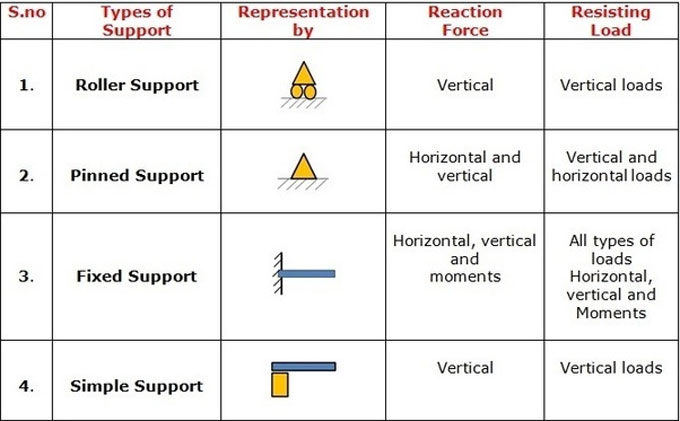
Different types of supports in building structure
Support in a structure belongs to a member that facilitates the others member to withstand loads. Supports in a structure transmit the load to the ground and make the structure supported on it durable.
You should have adequate knowledge regarding the support detailing in case of steel structures. As for instance, a support column in a steel structure is attached on the basis of the detailing chosen.
Given below, the details about different types of supports:-
Fixed support: It is considered as the most inflexible type of connection. It controls the member in all translations and rotations so that the member can?t move or rotate in any direction. As for instance a column arranged in concrete that can?t distort, rotate or misplace. To improve the structural strength, minimum one inflexible support should be arranged. Beam fixed in wall is a proper instance for fixed support.
The fixed supports are suitable when a single support is utilized. The fixed support offers all restraints required to make sure that the structure is stable. It?s the only support that can be applied for stable cantilevers.
Since the concrete continues to attain strength, it also spreads out. So, it should be kept in mind that the support is designed perfectly otherwise the expansion could result in minimizing the strength.
Roller support: Though this type of support can?t withstand the horizontal support, but it can withstand the vertical support. This connection can easily move in horizontal direction as there is no obstruction.
It?s application is mostly found in a bridge. Usually, a bridge comprises of a roller support at one end to take into account the vertical displacement and expansion due to temperature variation. It?s vital to resist the expansion so that no damage can occur to a pinned support.
Clear cover to exterior most RCC is given below :-
The roller support can?t withstand horizontal force since another support for structure is needed to get rid of the horizontal force.
To enhance the stability of the structure, the roller support is applied together with pin support.
Pinned support: A pinned support stands for a common type of support in civil engineering. Similar to hinge, this support facilitates the rotation to happen but not translation. It signifies that it can withstand the horizontal and vertical forces but not a moment.
Pinned supports are mostly found in trusses. By connecting several members with pinned connections, the members are pushed against one another to produce an axial force within the member. The benefit of this support is that the members do not contain internal moment forces, and is designed only in accordance with their axial force.
The pinned support does not have the capacity to fully withstand a structure independently when it is required minimum two supports to withstand the moment directing to the structure.
Internal Hinge: The main purpose of the interior hinges is to connect flexural members at points other than supports. In several occasions, it is applied purposely so that the additional load ruptures the weak zone in spite of damaging other structural components.


